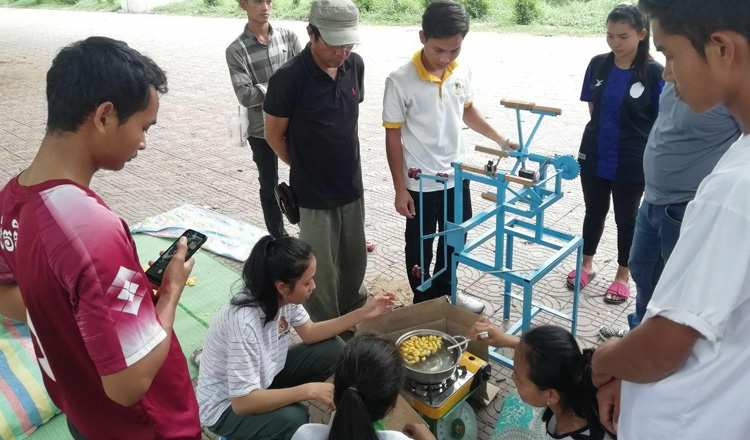Silk initiative reels in extra income for students
 Representatives from six universities in Cambodia and the Ministry of Education, together with a member of the World Bank discuss ways to help students to make some money related to silk processing. KT/Sok Chan
Representatives from six universities in Cambodia and the Ministry of Education, together with a member of the World Bank discuss ways to help students to make some money related to silk processing. KT/Sok Chan
Representatives from six universities in Cambodia and the Ministry of Education, together with a member of the World Bank discussed ways to help students to make some money related to the agriculture sector, processing and related work.
The universities are the Royal University of Agriculture, Institute of Technology of Cambodia, Royal University of Phnom Penh (RUPP), University of Battambang, Svay Rieng University and University of Heng Samrin Tboung Khmum.
In order to share knowledge and to help students to earn income, RUPP, through its Khmer Silk Centre, is now providing employment to a number of its students.
Speaking to Khmer Times, Mey Kalyan, chairman of the Board of Trustees at the Royal University of Phnom Penh, said RUPP’s students were taken through the process of silk reeling by the Aoral Silk Community, which also developed the reeling machines that the students used for training.
Selected students had the opportunity to learn practical silk yarn reeling techniques starting from the process of selecting cocoons, Kalyan said, adding that the training is initially provided by silk community leaders with the hope that the students will later pass these skills on to other members of their communities, generating employment while bolstering the production of Cambodian silk.
Around 26 students are working in the silk process at RUPP, working in five rotating groups to practise silk yarn reeling. Students can earn around $30 per week. Although it is a small sum, it could help release some burden on the students during the COVID-19 pandemic, Kalyan added.
This latest milestone by the initiative was made possible by the Mondulkiri and Aoral Silk Communities, the latter having successfully developed a reeling machine that can be operated both manually or by electricity. It takes three students to operate the machines and reel the cocoons into silk yarns, which have a market value of approximately $15 a kilogramme.
“The new reeling machine will change the industry. It is a cross between modern machines and traditional kinds often found in some Cambodian silk villages. We are trying to create more of these in order to generate a good source of income for students and communities who were affected by the crisis,” Kalyan added.
“We found that this method is more suitable for certain types of cocoons, yielding better quality silk yarns. Also, the machine requires a much lower capital investment. They are basic, which means they are easy to set-up, distribute and therefore a lot more accessible,” he added.
Ea Hoknym, chairman of the Aoral Silk Community in Kampong Speu province, told Khmer Times that there are four manual reeling machines deployed at RUPP. He said that he supplies the cocoons to the students monthly because they want to train the students on how to perform silk reeling in order to boost local silkworm production.
“We also plan to roll out this method to the community to give them jobs while they are free,” he added. “The small cocoon will be used only with the manual silk reeling machine, while the big cocoons will be sent to the automatic machine at the Aoral Silk Community,” he added.
“Students can get $15 a kilogramme of silk yarn. Ten kilogrammes of cocoon can produce only one kilogramme of silk yarn. A kilogramme of cocoon costs $7. A kilogramme of finished silk yarn is worth $90 to $100,” Hoknym added, emphasising the value chain.
Kalyan said over time more and more students have shown interest in reeling silk yarn and in growing mulberry plants that are necessary for rearing healthy silkworms. The plant’s leaves are the worms’ staple diet.
“We anticipate seeing a transfer of skills and knowledge at a community level, which
is quite exciting. We hope this would also benefit senior populations and women in rural areas by providing them with activities and a livelihood that allows them to stay with their families and in their homes. This is one of the reasons we began this initiative in the first place and I believe this could potentially play a big part in increasing mulberry planting and keeping the silk industry alive in Cambodia.”
Credited: Khmer Times






